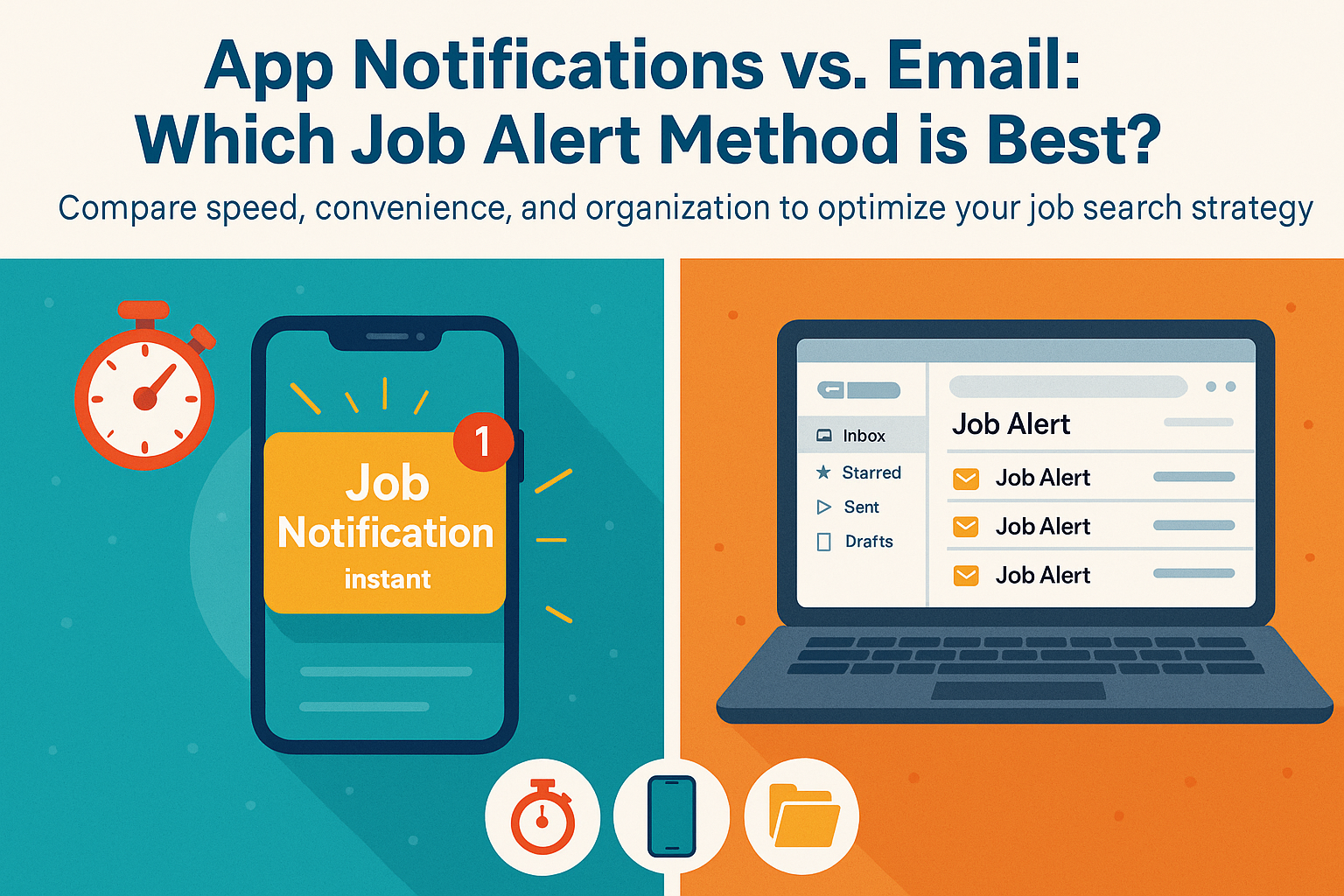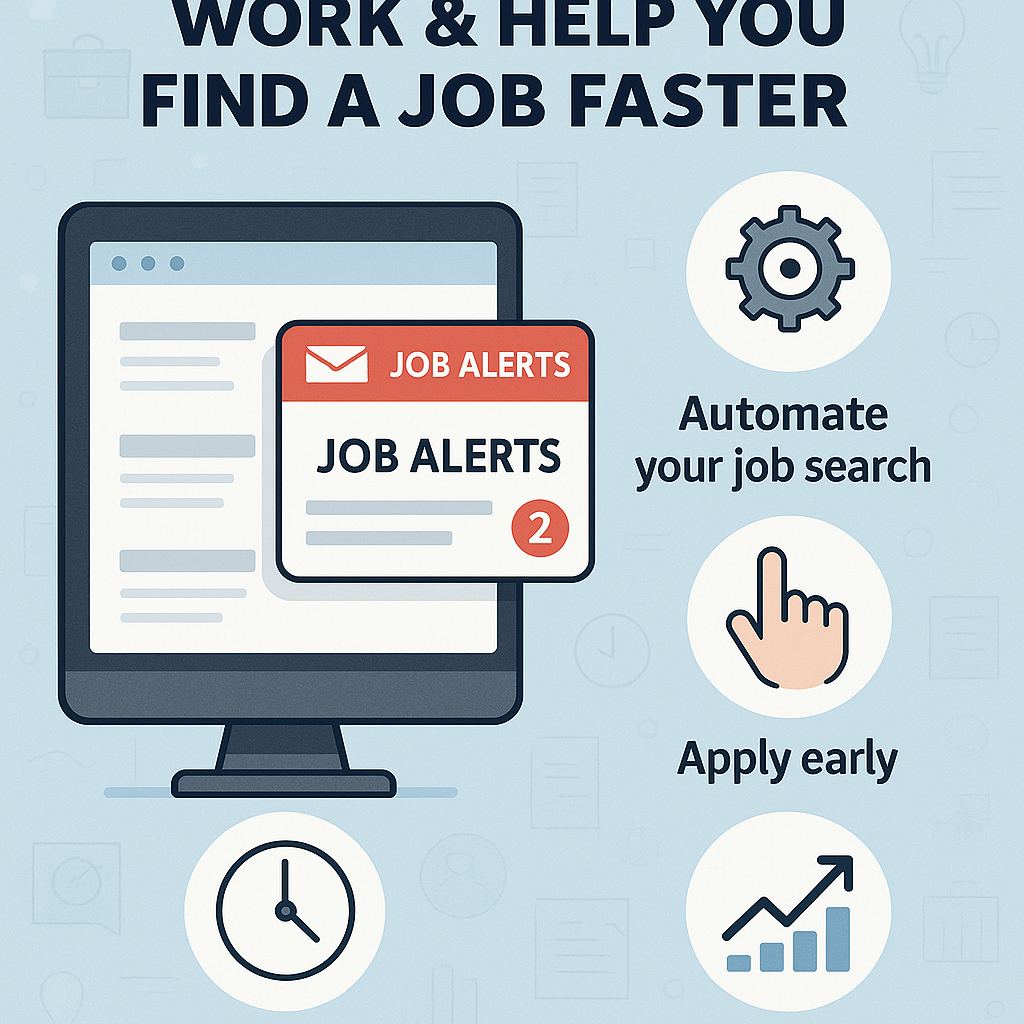How to Use Job Alerts to Stay Ahead of the Competition

Should you use app or email job alerts? Compare both methods for speed, convenience, and organization to build the...

Learn how job alerts work to automate your job search. Discover why using them helps you apply early, save time, and...

Learn how to use job alerts effectively to apply early, personalize your applications, and stand out in a...

Should you use email or app alerts for job updates? Compare both methods and choose the best one for your job search...

Learn the biggest mistakes job seekers make with job alerts and how to fix them for better job matches, faster...

Learn how to create targeted job alerts using the right filters so you can find better roles faster, without wasting...

Learn how job alerts work, why they save time, and how to set them up to get the right job notifications directly in...
Resources
-

Set up personalized job alerts to receive notifications about new job openings that match your...
-

Find part-time job opportunities perfect for students, parents, and professionals seeking...
-

Work from home jobs across industries with flexible hours, competitive pay, and real career...
-

Create professional resumes with easy-to-use resume builders. Choose from templates, get...
-

Kickstart your career with internships tailored for students and graduates — explore paid,...
-

Remote jobs have revolutionized how we work, giving professionals the freedom to contribute from...
-

Find the best fresher jobs and entry-level opportunities across IT, Finance, Marketing, and...

How to Use Job Alerts to Stay Ahead of the Competition
Every second counts when you're searching for a job. You spend hours perfecting your resume, only to send it into the digital void of an online application portal. Days turn into weeks with no response, leaving you to wonder if anyone ever saw it at all.
This is the reality of the modern job hunt. By the time you find a promising job post, apply, and get your resume into the system, hundreds of other applicants may already be ahead of you.
Recruiters are overwhelmed. To cope, they often focus on the first wave of qualified applications they receive. That window of opportunity can close with stunning speed.
This is where job alerts give you a powerful, strategic edge.
But simply setting them up and waiting is not a strategy. You need to use them as the engine of a proactive system to apply early, personalize your responses intelligently, and follow up at precisely the right moments.
In this guide, you will learn the specific, actionable steps to turn job alerts from a passive notification system into your most valuable tool for winning in a competitive market.
Why Timing Is Your Greatest Advantage in Competitive Markets
Imagine two candidates, both with impressive and similar resumes. Candidate A applies just two hours after a job goes live. Candidate B applies three days later. Which one do you think gets noticed?
Overwhelmingly, it is Candidate A. Recruiters spend the most time and energy on the first few dozen applications they receive. The rest are often skimmed or, in some cases, may not even be opened.
The reason is simple efficiency. Hiring managers operate under the assumption that the most organized, eager, and motivated candidates are the ones who are prepared to apply immediately.
An early application signals genuine interest and readiness. A late one, even from a highly qualified individual, can get lost in the noise.
How Job Alerts Give You a Competitive Edge
A well-managed system of job alerts is what allows you to be Candidate A every single time. It directly addresses the biggest challenges of the modern job search.
-
You can apply within hours, not days. This is the single most important factor in increasing your visibility. An alert delivered to your phone or inbox the moment a job is posted allows you to act while you are still among the first wave of applicants.
-
You can spot patterns in the market. By reviewing daily alerts, you start to see which skills, keywords, and qualifications employers in your field are consistently looking for. This insight is invaluable for tailoring your resume.
-
You filter out irrelevant and time-wasting roles. A precise alert system ensures you only spend your energy on opportunities that are a genuine match for your profile and career goals, preventing job search burnout.
-
You can focus on quality, not just quantity. When you aren't wading through hundreds of mismatched listings, you have the mental space to craft high-quality, personalized applications for the jobs that truly matter.
Platforms like JobPe further enhance this by allowing you to create filters for remote work, beginner-friendly roles, and specific industries, so you never waste time chasing the wrong opportunities.
Step 1: Create Focused, Specific Job Alerts
The most common mistake people make is creating alerts that are far too broad. An alert for "Marketing" or "Internship" is guaranteed to flood your inbox with irrelevant jobs.
This leads to notification fatigue, where your brain learns to ignore the constant stream of low-quality alerts, causing you to miss the golden opportunities when they finally appear.
The Strategy of Precision
Instead, your goal is to create a small portfolio of highly focused alerts. Think of yourself as a sniper, not a machine gunner.
-
Use highly specific job titles. Do not use single-word searches. Instead of "Sales," use "Sales Development Representative." Instead of "Content," use "Entry-Level Content Writer."
-
Include essential, non-negotiable filters. Every filter you add makes your results more relevant. Always include filters for:
- Location: Be specific, for example, “Remote (US)” or “Bangalore.”
- Experience Level: Use terms like “Entry-Level,” “Fresher,” or “Associate.”
- Industry: If relevant, narrow your search to “EdTech,” “FinTech,” or “Healthcare.”
-
Use multiple distinct alerts for different career paths. It is far better to have three to five separate, specific alerts than one generic one. This allows you to explore different interests without muddying your results.
Example Alert Setup
Imagine you are a recent graduate interested in a few different areas. Instead of one alert for "jobs for freshers," your setup on JobPe might look like this:
- Alert 1: “Remote Customer Support Intern” + “Entry-Level”
- Alert 2: “Content Writer Fresher” + “Marketing Industry”
- Alert 3: “Frontend Developer Trainee” + “HTML/CSS”
This methodical setup ensures that every notification you receive is one that you would genuinely consider, saving you time and mental energy.
Step 2: Turn on Instant or Daily Alerts
Speed is your primary advantage, and your alert frequency settings directly control that speed. If you are using the default weekly setting on most platforms, you are consistently too late.
Jobs posted three or even two days ago may already have a sufficient pipeline of applicants. You need to hear about opportunities almost as they happen.
Choosing Your Frequency
Your setup should be strategic, using different frequencies for different priorities.
-
Instant Alerts (Push Notifications): Reserve these for your absolute top-priority searches. These are your "dream job" alerts where every second counts. Use a mobile app for these so you get notified immediately.
-
Daily Email Summaries: This is perfect for your secondary searches. A single email digest delivered at the same time each day gives you a full list of opportunities you can batch process without constant interruptions.
Building a habit around this is key. Set a specific time every day, perhaps at 9 a.m. with your morning coffee, to review your daily alerts. This routine makes the job search feel manageable and less overwhelming.
Step 3: Be Resume-Ready—Always
Many job seekers lose precious time because they have to find, edit, and tailor their resume every single time they want to apply. In a fast-moving job market, that 30-minute delay can be the difference between getting an interview and being application number 357.
The solution is to prepare your application materials in advance. This starts with creating a "Master Resume."
A Master Resume is a comprehensive document, often several pages long, that lists every skill, project, accomplishment, and role you have ever had. You never send this document out. It is your personal database.
From this master document, you create two or three tailored versions that are ready to go at a moment's notice.
-
The General Resume: This is a strong, one-page summary of your most impressive skills and experiences. It's versatile and can be used for a wide range of applications where heavy customization isn't needed.
-
The Role-Specific Resume: You should have a separate version for each major career path you are pursuing. For a content role, it will highlight writing skills and portfolio links. For a tech role, it will prioritize programming languages and projects.
-
The Remote-First Resume: If you are targeting remote work, this version should prominently feature skills essential for remote success. This includes your proficiency with tools like Slack, Asana, and Trello, and soft skills like self-discipline and asynchronous communication.
Use a tool like the JobPe Resume Builder to create, store, and easily update these versions. A quick review once a week is all you need to keep them current.
Step 4: Use Auto-Apply Tools Wisely
Platforms like JobPe Auto-Apply can automatically submit your application the moment a new job matches your pre-defined criteria. This tool offers an incredible speed advantage.
It is an especially powerful strategy for:
- Internship seekers applying to many similar roles.
- Remote job hunters in competitive global markets.
- Freshers applying in high volumes to gain experience.
However, automation must be used strategically. It works best when your resume is already highly optimized for the specific roles you are targeting, and you are using it for a segment of your search where speed is the most important factor.
Auto-apply helps you be the first in the inbox. For many high-volume roles, this is what gets you past the initial screening and leads to more interview calls.
Step 5: Personalize Fast—Even When Automated
Sending the exact same resume to every single job will limit your success. Recruiters can spot a generic application from a mile away. But this does not mean you need to write a new cover letter from scratch every time.
You can develop a system for rapid personalization.
-
Customize Your Resume Summary: Add a single, targeted sentence at the top of your resume. For example: “Actively seeking a support role in the EdTech industry where I can apply my passion for customer empathy and clear communication.”
-
Use a Templated Cover Message: Prepare a short, effective template that you can quickly edit. The key is to have placeholders for the most important details.
Example Personalization Template:
Hi [Hiring Manager Name],
I saw the opening for the [Role Name] at [Company Name] and was immediately excited to apply. I have been following your work, and your recent [Mention a specific project, campaign, or company value] really stood out to me.
My experience in [Mention a key skill or experience] aligns well with the requirements of this role, and I would love the opportunity to contribute to a growing team like yours.
- The Follow-Up Message: If you choose to follow up, send a short, polite message that reminds the recruiter of your application and reiterates your interest.
Step 6: Build a Daily Job Hunt Workflow
Job alerts are a tool, but they are most effective when they are part of a consistent daily habit. A structured routine prevents procrastination and makes the entire process feel less daunting.
Here is a simple but powerful 30-minute daily routine:
- 5 minutes: Open your dedicated job alert folder or daily email digest.
- 10 minutes: Quickly scan the list and open the top 3-5 most promising roles in new tabs.
- 10 minutes: Apply to these roles using your pre-saved, tailored resumes and your rapid personalization template.
- 5 minutes: Log your applications in a tracker.
Your tracker can be a simple spreadsheet in Google Sheets or a board in an app like Notion or Trello. It should include:
- Job Title
- Company Name
- Date Applied
- Source of Alert (e.g., JobPe, LinkedIn)
- Status (e.g., Applied, Interviewing)
- Follow-up Date
This simple log prevents you from applying to the same job twice and provides a clear reminder of when to follow up.
Step 7: Follow Up on Promising Roles
Submitting your resume is not the end of the process. A polite and professional follow-up can double your chances of getting a response. It brings your name to the top of the recruiter’s mind and shows initiative.
How to Follow Up Correctly
- Wait 3-5 business days after you apply. This gives them time to review initial applications.
- Find the right person. Look for the company’s HR manager or a recruiter on LinkedIn.
- Send a short, polite message. Your goal is to be helpful, not pushy.
Hi [Name],
I hope you are having a great week. I recently applied for the [Role Name] position at [Company Name] through [Platform]. I am very interested in this opportunity and confident that my skills in [Mention 1-2 key skills] would be a great asset to your team.
I would be glad to provide any additional information you might need. Thank you for your time and consideration.
Even if you do not get a reply, this small act of professionalism sets you apart.
Step 8: Keep Improving Your Alerts
Your job search strategy should not be static. You need to review your alerts every few weeks to ensure they are still performing well for you.
Ask yourself these questions:
- Are the alerts delivering roles that still match my interests?
- Am I seeing too many duplicates or irrelevant job postings?
- Is my application tracker showing that these alerts are leading to interviews?
If the answer to any of these is no, it is time to tweak your system. Adjust your keywords, add or remove filters, or change the platforms you are using. Use the data from your application tracker to make informed decisions.
Pro Tip: Use Multiple Platforms Strategically
The most effective job seekers do not rely on a single website. However, trying to manage ten different platforms is a recipe for burnout. The best approach is to choose two or three platforms strategically.
- Your Primary Platform: This should be your main source, like JobPe, for fresher, remote, and internship roles.
- Your Secondary Platform: Use a site like LinkedIn for networking and roles at large, established companies.
- Your Niche Platform: Consider an industry-specific site, like Wellfound for startups or a board specific to your field.
Set up your alerts on these platforms and use email folders to keep the notifications organized and separate.
Final Word: Stay Ahead by Staying Ready
Job alerts are only effective when you are prepared to act on them. It is not enough to simply get notified of a job opening; the strategy is to be the first to apply, and to do so with a high-quality, personalized application.
To achieve this, you need a system.
Use the right keywords to create focused alerts. Check those alerts daily as part of a routine. Apply quickly with a tailored resume that is ready to go. Follow up professionally to show your enthusiasm. And finally, keep improving your system based on what works.
When you pair a smart alert system with powerful tools like JobPe’s auto-apply feature, resume builder, and interview prep guides, you transform your job search from a game of chance into a strategy for success.
Don’t just wait for the right job to appear. Be the first one ready when it shows up.
